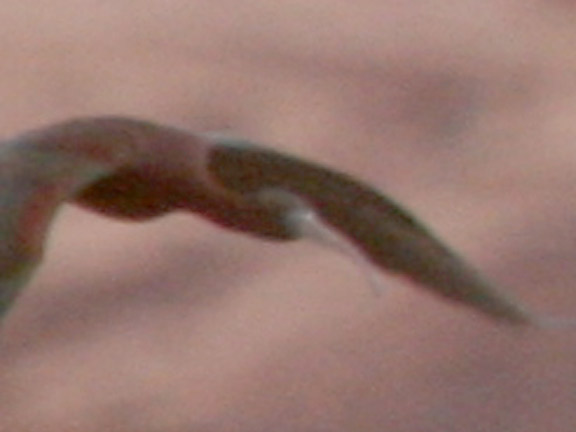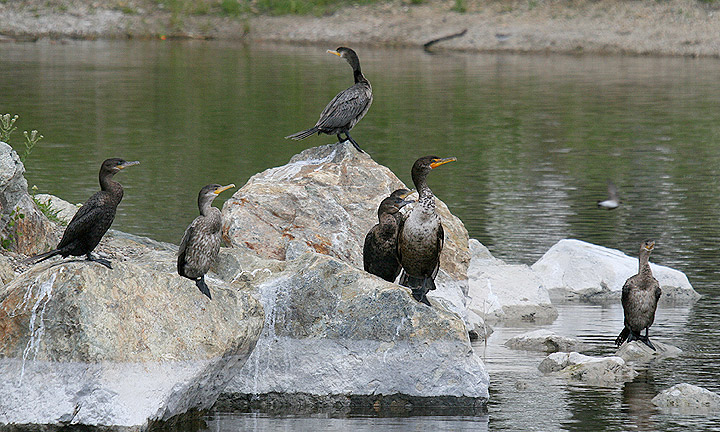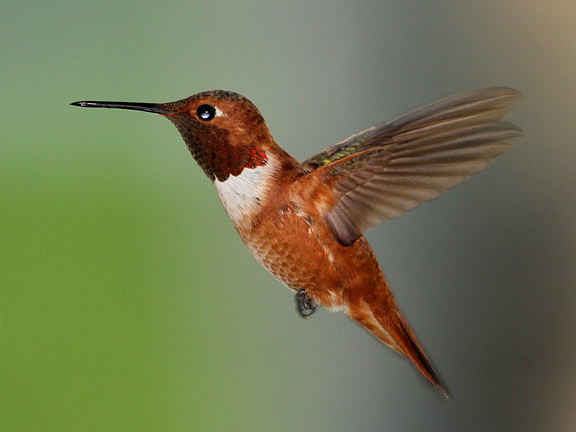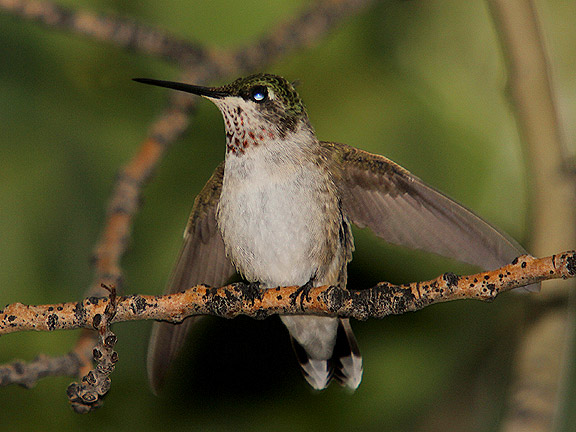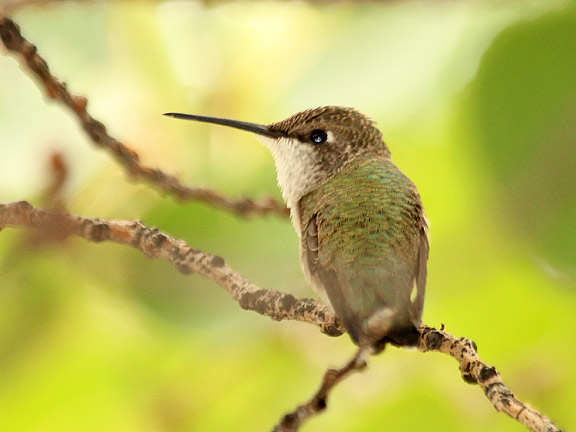My senior year of college I asked and my dad agreed to help me buy a a Canon 100-400 IS lens so I could work on wildlife photography. I was graduating with a degree in Studio Art and had concentrated on photography and graphic design and wanted to do wildlife photography. I remember the week I got the lens, taking it out on campus right as spring migration was heating up. I took what is still my best photo of a Yellow-bellied Sapsucker, along with a handful of shots of species I haven't photographed since that spring in Wisconsin 7 years ago. It was a spectacular lens, especially for someone who had used cheap plastic lenses the previous couple years. Night and day as they say.
Yellow-bellied Sapsucker taken with the
Canon 100-400mm lens in 2005.
I had agreed to pay my dad back for the lens, but after it became apparent that I wasn't going to make it as a wildlife photographer, and that the stiff job market at the time kept me working in retail for a year--he just told, "don't worry about it.". But a year after that I finally had a job, and some money in my pocket--so being a ripe young 24 year old, I went out and made a lofty purchase of a Sigma 50-500 lens to accompany the Canon. I thought the 500mm would bring me closer, and better pictures--but part of my inexperience was that I didn't realize the lenses were in different leagues. The 500 took pretty good images--but I never loved the colors I got and it just didn't produce the same quality. It was a cheaper lens, but occasionally it found it very useful, and it became a staple in my camera bag. It was a useful backup lens for years, and the range form 50-500 made it worthwhile to use when I was in a location where the birds and the scenery were both on my mind for photos.

Me with the old (new at the time) Sigma 50-500mm lens in 2006.
Early in 2011 I started noticing that quite a few pictures through my Canon were coming out soft. I could see dust inside the lens, there were blurred shots because the image stabilization didn't appear to be working all that great, and in general unless a bird was within 20 feet, the pictures were just okay. I made it work most of the time, and despite being worried about how the lens would perform in Costa Rica last summer, I failed to get it repaired because I didn't want to spend the money at the time. And I will admit I likely paid for it in terms of quality of a lot of what I photographed while there. Afterwards I kept at it, until this winter when I was photographing hawks and took a lot of bad photos. I switched too the 50-500, which in contrast seemed to be taking better pictures. Looking back I now realize how bad the Canon had gotten, while the seldom used Sigma was still like new.
Harlan's Hawk photo taken with the old 50-500mm Sigma
this past winter.
I recently did the math and guess that I shot anywhere from 150,000-250,000 shots through the Canon. Shooting anywhere from 20,000-40,000 shots a year (mostly wildlife) I would say I probably got the lenses worth out of it. As the winter wore on I was using the Sigma everyday, taking around 200 shots a day for several weeks as I spent my lunch hours watching wintering raptors. Then one day my camera was on my desk at work, half in it's back, but unzipped, when I turned and my chair arm snagged the backpack pulling it off the desk, only a couple feet high. But when I looked down I could see the lens was separated from the camera body, and the damage was severe. The bracket was still attached to the camera, and all the screws that held it to the lens had pulled loose. The digital ribbon inside the lens was torn in half, and a number of gaskets were bent. It was a mess.
I put the 100-400 back on the camera and put the Sigma back in its boxes figuring, I would take it to a repair shop sooner or later to see what they could do. since then the 100-400 has been my staple. I have seen the same quality issues, but as with the previous year made it work. As we have been planning for Peru, photography has been heavy on my mind. This is likely to be a trip I won't be repeating any time soon--so I wanted to make sure everything I photograph is as good as I can make it. And the Canon lens had me worried. So after weeks of deliberating on what to do--I finally bought a new backup lens. I honestly wasn't sure what to do--I thought about getting another Canon 100-400 to have a new crisp clean lens. I would send mine back to be repaired and then sell it. Or would I spend a 3rd less and get something like a Tokina that had descent reviews, but was noted as being "no Canon" in various reviews. It was a true backup lens. Then there was of course Sigma. I had always been keen on them, but the same lens no cost more than the Canon. It had been major league upgraded, but I couldn't see myself spending more on a lens that if it had similar glass to the last one, wasn't worth the price tag. That left the Sigma 150-500 lens. An image stabilized lens but about 1/2 the price of the 50-500.
Reading reviews they were highly positive and it seemed like a right choice. With less of a zoom factor I imagined the distortion may be less, and with image stabilization it had something the last lens didn't that made it all the better. So I went ahead and ordered it. I got my Canon ready to ship back, but decided I would wait to test the Sigma out to see if I had mad ea good decision, or if I would be instead sending it back, and trying something else. Yesterday afternoon the package arrived at my house, and when I got home, I unpacked it, gave it the once over, and hooked it up to the camera.
The new Sigma 150-500mm lens
The first bird to come in was a female black-chinned Hummingbird, and in a volley of shots, not one came out crisp and clear. I had forgot to change the settings, and still had the ISO at 1600 from the night before. Everything got washed out with the flash and it wasn't a good test. I decided to wait till the sun dipped behind the Ponderosas in my neighbors yard so the lighting would be more adequate for the flash. After 7:00pm I was back at the window, and the male Rufous Hummingbird that has been King of the Mountain all week started his routine. After toying with the settings a little bit, I started to get the pictures I had been hoping for--but even better.
Rufous Hummingbird with the new Sigma Lens
It was a start contrast to the quality I had come to know with the beaten up Canon lens--the Canon that was a far cry from its once top of the line zoom self. It was also night and day between the old Sigma in terms of clarity, color and quality. I was getting the shots I never got with the previous Sigma. The hummingbird only came in 2 or 3 times, so I made the best of it and was able to unleash a flurry of shots each time it stopped by. Below are two shots, the one on the left taken today with the Sigma, and the one on the right taken a few days ago with the Canon. Same time of day and location, very similar settings, but very different results.
Left photographed with Sigma, Right with Canon
This of course was just one test with one bird coming to feeders. I will need to take it up in the mountains and out to the lake to see how it performs in other settings. But for a first glimpse into what it can do I am very happy with this lens. I have a feeling that this will be the primary lens I use in Peru and after.
Closeup of the New Sigma Lens
Now talking about the actual lens there are some major differences from the predecessor worth noting. First is the 150-500mm range, which I do think I will appreciate more in the long run. The lens hood has been updated to a similar style as the canon instead of a 1/3 hood like many short lenses use--this provides more protection for that front element which is never a bad thing. Image stabilization! This might be the single best improvement made to the lens. At 500mm it is a big lens, and heavy, and when hand held it's sometimes hard to keep things crisp. The IS should help with that, and overall improve the quality of the shots. The weight of the lens is also less than the previous version. I don't know the exact amount, but it seems like a pound or more of weight was cut out of this lens. The flip side is the reason. The outer body now appears to mostly be of a resin, and/or plastic instead of the metal body of the previous version. Internal parts till appear to be high quality, but the the casing does have a"cheaper" feel about it. That is probably the only concern I have, but the lighter weight may be worth it.

One more of a beautiful Rufous Hummingbird
All in all I can say I am happy with the update, and having a new lens is always a nice feeling. The true test will be how it performs for the 2 weeks in South America. Until then it's all just practice I guess!
Labels: cameras, hummingbirds, lenses, photography, review
